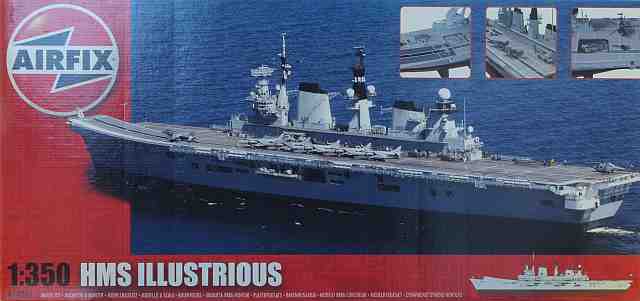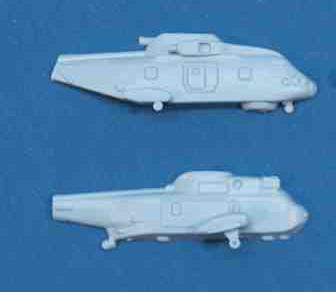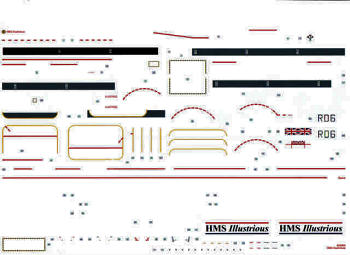Airfix 1/350 HMS Illustrious
|
KIT #: |
A14201 |
|
PRICE: |
60.00 Euros
|
|
DECALS: |
One option |
|
REVIEWER: |
Frank Spahr |
|
NOTES: |
276 parts, 24 inches in length |

1966 was a fateful year
for British Naval Aviation. Mostly for budgetary reasons, the government
cancelled CVA-01, a new attack carrier that should have started a
modernization of the ageing carrier fleet. Both Britain´s difficult economic
situation and exaggerated views on the capabilities of land-based air power made
the administration go yet a step further: They decided to outright abandoning
the entire carrier fleet over the course of the next years, when Britain would
withdraw her forces from her former colonies and the area „East of Suez“. The
rationale was that what limited financial means available were to be
concentrated on core capabilities and commitments related to NATO, which were
convoy escort and ASW in the North Atlantic, the infamous GIUK gap
(Greenland-Iceland-UK),
Obviously, a devastated
admiralty tried all they could to preserve at least a modicum of naval air
assets. So new large helicopter-carrying ASW vessels were proposed and
ultimately approved. The ships were originally termed as „through-deck cruisers“
and became the Invincible class. No traditional carrier name was chosen to
emphasize the ships Not Being Carriers. In the course of the lengthy
design phase it was decided to equip the Invincibles with point-defence
fighters against the Tu-95 „Bear“ maritime surveillance aircraft. To this end, a
navalised version of the Harrier VTOL aircraft was developed and termed the Sea
Harrier. To enable these aircraft to operate with useful payloads and in bad
weather, the „ski-jump“ was developed while the lead ship Invincible was
already building. Two years after the last carrier with fixed-wing aircraft had
been retired, Invincible was commissioned in 1980, after successful
trials. As a sign of a change in attitude she revceived the „R“ designation for
a carrier instead of a „C“ for a cruiser, and her sisters were to receive the
classical carrier names of Illustrious and Ark Royal.
Yet the next wave of cuts was already
rolling with the infamous Nott review of 1981, and amongst other severe cutbacks
it included seeling Invincible to Australia, thus reducing the class to
two vessels. Even while this was in the process of implication, Argentina
invaded the Falklands.
First Sea Lord,
Admiral of the Fleet Sir Henry Leach, son of the Captain John Leach who
was lost in the Prince of Wales in December 1941,
intervened with the
Prime Minister and convinced her of attempting to retake the islands, using
Invincible and the older carrier Hermes as centerpieces of the Battle
Group. Despite poor odds and thanks to tremendous commitment and powers of
improvisation on the part of all concerned, the operation succeeded, leading to
a reassessment of naval sea power and to a reduction of the proposed cuts.
Two glaring defects of
the fleet were soon rectified; Vulcan Phalanx automated close-in weapon systems
were retrofitted to all three carriers, and an AEW version of the Sea King
helicopter was introduced, both measures improving fleet defence a lot – had
both been implemented earlier, probably a number of ships would not have been
lost and many men would not have died.
In the decades since
their introduction, all three vessels of the class have seen numerous exercises,
humanitary missions, but also combat missions. They were deployed to the
Adriatic during the Balkan wars, to the Persian Gulf and the Indian Ocean during
both Gulf Wars and the Afghanistan war.
Successively they have
been modernized with a view to squeeze as many aircraft into the given very
limited space and to enhance their flexibility. These days, the ships can
operate as classic light carriers, but also as commando carriers. Ark Royal
has also been refitted to operate AH-64 helicopters.
Invincible
was de facto taken out of service in 2005; in 2006, the Sea Harrier was also
stricken from the inventory due to poor performance in the warm climates most
combat has taken place in the new century. Currently, and until the two (or
maybe one?) new large carrier(s) are actually commissioned, Britain´s carrier
fleet comprises the two remaining vessels of the class, equipped with
helicopters and RAF ground-attack versions of the Harrier.
Over the past 30 years,
the Invincible class ships have developed from a stop-gap measure to very
flexible and true carriers despite their small size.
 You need to go back to 1982 (yes, the
Falklands, Helmut Kohl becomes our chancellor, The Conch Republic is declared,
the first CD´s are sold) for the previous release of an Airfix warship kit, at
least according to the Airfix Tribute Forum, and I regard them as pretty
thorough. That was HMS Repulse, and coincidentally the to date last Airfix 1:600
kit. It took 27 years, almost as long as the Berlin Wall stood, until this kit
of HMS Illustrious was issued. This vessel was probably chosen for her TV
celebrity status from the Channel 5 series „Warship“. It is interesting to note
the switch in scale to the currently booming 1:350.
You need to go back to 1982 (yes, the
Falklands, Helmut Kohl becomes our chancellor, The Conch Republic is declared,
the first CD´s are sold) for the previous release of an Airfix warship kit, at
least according to the Airfix Tribute Forum, and I regard them as pretty
thorough. That was HMS Repulse, and coincidentally the to date last Airfix 1:600
kit. It took 27 years, almost as long as the Berlin Wall stood, until this kit
of HMS Illustrious was issued. This vessel was probably chosen for her TV
celebrity status from the Channel 5 series „Warship“. It is interesting to note
the switch in scale to the currently booming 1:350.
The strong and large box
is rather heavy and packed to the brim. Sadly the sprues have not been sealed
individually as most major manufacturers do today, that obviously leads to
damaged parts. The kit comprises a bit less than 300 parts on five sprues. In my
kit, all of them are crisply molded and free of flash. Despite some really
sturdy parts, I found almost no sink marks – but there are some ejector pin
marks in untoward places. The level of detail is pretty decent and in fact
better than I expected, but it (yet) is not on par with the leading edge
manufacturers. Nonetheless this is very welcome progress and and very useful
base for a fine model!
Sprue A contains the hull
sides, some decks and the aircraft lifts. These can be positioned at one of
three levels – a clever idea!
 Sprue B is dominated by the one-piece
flight deck and the hangar deck. These large parts look promising, not only
because Airfix omitted exaggerated structures.
Sprue B is dominated by the one-piece
flight deck and the hangar deck. These large parts look promising, not only
because Airfix omitted exaggerated structures.
Sprue C has lots of parts for the
island, and the underwater hull. The walls of the island are fairly well
detailed. The demarcation line of the lower hull is at the lower end of the boot
topping which I regard as a splendid idea, as it eases building a waterline
version. You virtually always see at least part of the boot topping, so having
it at the lower hull means either gluing it on and cutting it off a bit below
the demarcation, or adding some sheet to the hull. So I will probably leave the
lower hull off for a waterline display.
A lot of equipment is to be found in
sprue D. Most notable are the sea boats, the davits, the Goalkeeper CIWS, the
deck vehicles and the life raft canisters.
 The final sprue E comprises the sadly
small air group. There are two Sea Harriers and two Harriers GR.7. This narrows
the era down to between 2004 (Illustrious´ last major refit) and 2006 (the Sea
Harrier´s retirement). Two Merlin and two Sea King helicopters complete the
aircraft. One of each is to be depicted with folded wings. Sadly, the folded
wings have only three instead of five blades.
The final sprue E comprises the sadly
small air group. There are two Sea Harriers and two Harriers GR.7. This narrows
the era down to between 2004 (Illustrious´ last major refit) and 2006 (the Sea
Harrier´s retirement). Two Merlin and two Sea King helicopters complete the
aircraft. One of each is to be depicted with folded wings. Sadly, the folded
wings have only three instead of five blades.
The very visible Searchwater radome
of the AEW Sea King had been omitted. generally speaking, the aircraft are
fairly well-detailed, with some questionable aspects like the molded-on missile
pylons on the Harriers and the pretty clunky sponsons of the Sea King. The
recessed panel lines are rather on the heavy side. I assume that some TLC with
Mr Surfacer should tone them down enough to work fine under a coat of paint, or
some. All the aircraft should build well and provide a good starting point for
whatever detailing you should intend to perform. In my eyes, the most serious
drawback is the sheer lack of aircraft. There is yet the possibility of Airfix
selling the aircraft sprue as a separate detail set, which would be both easy
and logical for them, but this has yet to materialize, a year after the kit was
issued.
The kit instructions are
almost perfect. After the sprue layout, construction is shown in numerous and
clearly arranged steps. Colour callouts are Humbrol numbers, as usual. My only
area of dissent is in the construction sequence: I would never add the
 lower
hull as late as shown, let alone after gluing the shafts, props and rudders to
it. Apart from that, the sequence is logical.
lower
hull as late as shown, let alone after gluing the shafts, props and rudders to
it. Apart from that, the sequence is logical.
The large decal sheet is
well-printed and seems in register, something not exactly a given in earlier
Airfix offerings – I obviously will only be able to tell you how they work as
soon as I do work with them. The complex flight deck markings are nicely
reproduced, so this sheet should help up the model a lot.
To ease painting and
decal placement, a colour profile has been added showing all you need to know
concisely. This is yet another strong point of the kit, compared with the
classic Airfix ships. This profile contains all the colour callouts both in
Humbrol and in British Standards.
All in all this is a
highly recommended kit of a very interesting class of ship. Airfix has proven
their intent to do something more than rebox and reissue, that they are working
to improve their offerings and to narrow the gap between their offerings and
today´s best ones. Even though this is no Dragon Smart Kit, I don´t mind a bit.
I´m sure this will be an enjoyable build and one with tons of potential!
Frank Spahr
September 2010
If you would like your product reviewed fairly and quickly, please
contact
me or see other details in the
Note to
Contributors.
Back to the Main Page
Back to the Previews Index Page


 You need to go back to 1982 (yes, the
Falklands, Helmut Kohl becomes our chancellor, The Conch Republic is declared,
the first CD´s are sold) for the previous release of an Airfix warship kit, at
least according to the Airfix Tribute Forum, and I regard them as pretty
thorough. That was HMS Repulse, and coincidentally the to date last Airfix 1:600
kit. It took 27 years, almost as long as the Berlin Wall stood, until this kit
of HMS Illustrious was issued. This vessel was probably chosen for her TV
celebrity status from the Channel 5 series „Warship“. It is interesting to note
the switch in scale to the currently booming 1:350.
You need to go back to 1982 (yes, the
Falklands, Helmut Kohl becomes our chancellor, The Conch Republic is declared,
the first CD´s are sold) for the previous release of an Airfix warship kit, at
least according to the Airfix Tribute Forum, and I regard them as pretty
thorough. That was HMS Repulse, and coincidentally the to date last Airfix 1:600
kit. It took 27 years, almost as long as the Berlin Wall stood, until this kit
of HMS Illustrious was issued. This vessel was probably chosen for her TV
celebrity status from the Channel 5 series „Warship“. It is interesting to note
the switch in scale to the currently booming 1:350. Sprue B is dominated by the one-piece
flight deck and the hangar deck. These large parts look promising, not only
because Airfix omitted exaggerated structures.
Sprue B is dominated by the one-piece
flight deck and the hangar deck. These large parts look promising, not only
because Airfix omitted exaggerated structures. The final sprue E comprises the sadly
small air group. There are two Sea Harriers and two Harriers GR.7. This narrows
the era down to between 2004 (Illustrious´ last major refit) and 2006 (the Sea
Harrier´s retirement). Two Merlin and two Sea King helicopters complete the
aircraft. One of each is to be depicted with folded wings. Sadly, the folded
wings have only three instead of five blades.
The final sprue E comprises the sadly
small air group. There are two Sea Harriers and two Harriers GR.7. This narrows
the era down to between 2004 (Illustrious´ last major refit) and 2006 (the Sea
Harrier´s retirement). Two Merlin and two Sea King helicopters complete the
aircraft. One of each is to be depicted with folded wings. Sadly, the folded
wings have only three instead of five blades. 